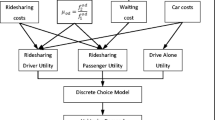Abstract
This paper proposed an optimal matching problem between drivers and riders for ride-sharing. The model assumes that all Space-time Extended Network (STEN) links have measurable utility based on the activity desired by each user. The ride-sharing service is designed to maximise the social utility of all users while considering the capacity constraints of vehicles. As user activity over the entire study period is taken into account, the model accommodates changes, and even cancellations, in the timing of user activity without addition of any further parameters. Furthermore, the model allows evaluation of the diffusion effects of autonomous vehicles used for ride-sharing. A case study using a hypothetical network confirmed that autonomous vehicle diffusion not only reduced detours during pick-up, but also encouraged riders to travel. Vehicle diffusion increased total user utility and helped to equalise opportunities for user activities. Although autonomous vehicle diffusion may increase total travel time, this can be mitigated by vehicle-sharing.







Similar content being viewed by others
References
Cordeau, J.-F., Laporte, G.: The dial-a-ride problem: models and algorithms. Ann. Oper. Res. 153(1), 29–46 (2007)
Agatz, N.A.H., Erera, A., Savelsbergh, M.W.P., Wang, X.: Optimization for dynamic ride-sharing: a review. Eur. J. Oper. Res. 223, 295–303 (2012)
Agatz, N.A.H., Erera, A., Savelsbergh, M.W.P., Wang, X.: Dynamic ride-sharing: a simulation study in metro Atlanta. Transport Res. B-Meth 45, 1450–1464 (2011)
Najmi, A., Rey, D., Rashidi, T.H.: Novel dynamic formulations for real-time ride-sharing system. Transp. Res. E Logist. Transp. Rev. 108, 122–140 (2017)
Masoud, N., Jayakrishnan, R.: A decomposition algorithm to solve the multi-hop peer-to-peer ride-matching problem. Transport Res. B-Meth 99, 1–29 (2017)
Stiglic, M., Agatz, N., Savelsbergh, M., Gradisar, M.: Making dynamic ride-sharing work: the impact of driver and rider flexibility. Transp. Res. E Logist. Transp. Rev. 91, 190–207 (2016)
Aiko, S., Thaithatkul, P., Asakura, Y.: Incorporating user preference into optimal vehicle routing problem of integrated sharing transport system. Asian Transp. Stud. 5(1), 98–116 (2018)
Santos, D.O., Xavier, E.C.: Taxi and ride sharing: a dynamic dial-a-ride problem with money as an incentive. Expert Syst. Appl. 42, 6728–6737 (2015)
Li, Z.-C., Lam, W.H.K., Wong, S.C., Sumalee, A.: An activity-based approach for scheduling multi-modal transit services. Transportation. 37, 751–774 (2010)
Lam, W.H.K., Yin, Y.: An activity-based time-dependent traffic assignment model. Transport Res. B-Meth 35, 549–574 (2001)
Joh, C.H., Arentze, T.A., Timmermans, H.J.P.: Modeling individuals’ activity-travel rescheduling heuristics: theory and numerical experiments. Transp. Res. Rec. 1807, 16–25 (2002)
Fu, X., Lam, W.H.K.: Modelling joint activity-travel pattern scheduling problem in multi-modal transit networks. Transportation. 45, 23–49 (2018)
Bell, M. G. H. and Iida, Y.: Transportation Network Analysis, Chapter 1, Wiley, 1997
Transportation Networks for Research Core Team. Transportation Networks for Research. https://github.com/bstabler/TransportationNetworks. (August 2019 last access)
Shimamoto, H., Kurauchi, F., Iida, Y., Bell, M.G.H., Schmöcker, J.-D.: Evaluation of public transit congestion mitigation measures using passenger assignment model. J. East Asia Soc. Transp. Stud. 6, 2076–2091 (2005)
Author information
Authors and Affiliations
Corresponding author
Additional information
Publisher’s Note
Springer Nature remains neutral with regard to jurisdictional claims in published maps and institutional affiliations.
Rights and permissions
About this article
Cite this article
Shimamoto, H. Optimal Matching Problem for Ride-Sharing Considering Users’ Schedule Rearrangement. Int. J. ITS Res. 18, 391–399 (2020). https://doi.org/10.1007/s13177-019-00213-1
Received:
Revised:
Accepted:
Published:
Issue Date:
DOI: https://doi.org/10.1007/s13177-019-00213-1




